Based near the town of Corsica, in the southern part of South Dakota, the Vanden Hoek family have agriculture running through their veins. With a suckler, tillage and machinery enterprise, the business is run by Keith Vanden Hoek, and his two sons, Cody and Clayton.
The family run a herd of 210 spring calving suckler cows on 300 acres of grazing land. Weanlings are sold over three months, from December to February. Running a mix of black and red Angus cows and bulls, the herd also includes some Charolais cattle.
The family is currently calving, with all cows generally calved outdoors. Weanlings are typically sold in the local mart at a weight of 300-350kg. Last year’s crop of weanlings averaged $1,800 to $1,900/head, which is the equivalent of €1,690 to €1,780/head.
Grazing on leased ground is based on a daily rate, with the going rate for pasture grazing for a cow and calf at $2/day. Until last year, the family never made silage, all feed was dry and mostly hay. Last year, they sowed an alfalfa/oats mix, and wrapped it using an in-line tube wrapper. They were very impressed with the feed value and will continue this going forward.

This Vermeer baler features a fixed bale width of 5.1ft and a variable bale diameter of 3ft to 6ft.
The trio sow 2,100ac of crops and are aiming to grow this to over 3,000ac shortly. Last year, they sowed 1,000ac of maize corn and 900ac of soya beans, while the remainder was made up of whole crop and milo, which is a drought resilient sorghum. The rental market for tillage land in the area ranges from $175-$210/ac (€164-€197/ac). Crops are typically direct sowed, with little to no cultivation practices used on the farm. The crops are sowed using a 40ft Great Plains drill and a 16-row John Deere precision planter.
At present, the family are travelling up to 30 miles for ground, with their furthest two plots of ground 50 miles apart. South Dakota has experienced a warmer than usual winter, with weather at present dry and approximately 18-21 degrees Celsius.
Machinery dealership
The Vanden Hoeks set up Southside Farm Services over 17 years ago. The business sells new and used machinery, parts, crop seed and crop insurance.
It has the agency for Great Plains, an American cultivation and drilling equipment company, Kuhn hay and forage equipment, Vermeer and GTS specialist combine headers. The business employs two full-time staff, and the family’s mother, Val, looks after the administration work.
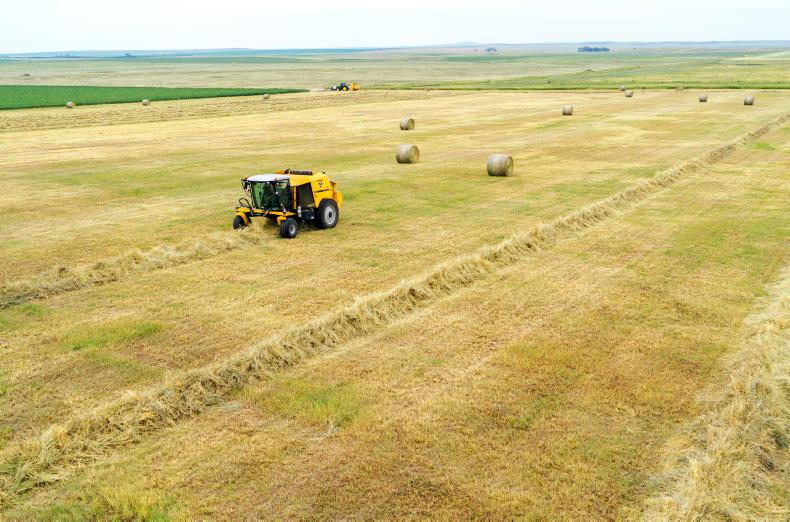
In 2017, Vermeer commercially launched the worlds first self-propelled round baler.
“We try to run everything on our own farm that we sell in our machinery business. That way, we have a great understanding of the machines and what our customers need.
“Our business could be described as being small to medium in size, but one that provides a very good service to a loyal customer base,” said Cody.
Self-propelled baler
Vermeer are an American company, who are a well-known and trusted brand in the United States. It has a European headquarters in the Netherlands, but by and large isn’t a recognised name in Ireland.
Vermeer has a big history with round balers, having introduced its first model in 1971. In 2017, Vermeer commercially launched the world’s first self-propelled round baler.
This wasn’t the world’s first self-propelled baler though, with several manufacturers building self-propelled square balers including Deutz-Fahr (PowerPress) and American firm Freeman.
Krone also toyed with the idea, but didn’t follow through. In saying that, the Vermeer machine is the first SP round baler on the market. 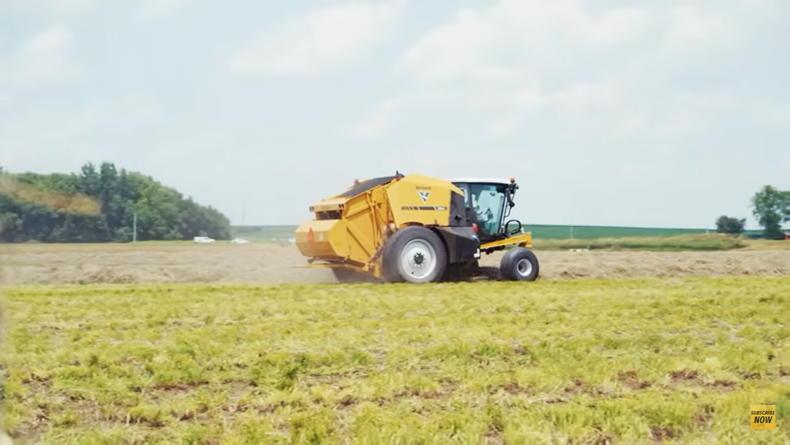
"If you get blocked, the hydraulically driven pick-up can be reversed, to help spit out the material before you start it up again, it’s a great job".
The family has run balers on their own farm for years. Fitting with the location and the climate, the Vanden Hoek’s have always used variable chamber belt machines.
Starting off with a twine New Holland, the family moved to Vermeer when they took on the agency many years ago.
Having stuck with Vermeer since, they decided to make the move to a new self-propelled ZR5-1200 model in 2019.
“We were really impressed with the look and build quality of the ZR5-1200 and decided to make the move in 2019. The machine is built to do one job, and is a phenomenal piece of kit.
As I say to farmers, you don’t see any trailed combines anymore, and there’s less and less trailed silage harvesters, so why wouldn’t you consider a self-propelled baler?” said Cody.
The nuts and bolts
The Vermeer machine sources power from a 200hp Cummins Stage V engine, which is married up to a two-speed hydrostatic transmission. In the field, forward speed is capped at 19.3km/h (12mph), while road speed extends to 48.3km/h (30+ mph). Weighing in at 8,845kg, the machine sources its cab from Claas, and it is the same cab used in the Jaguars and Lexions.
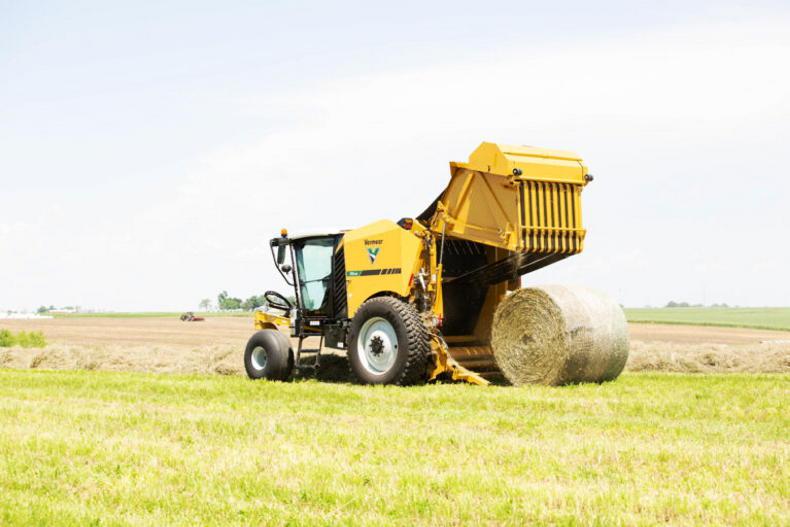
When the bale is made, the hydraulic power to the pick-up drops, and the bale chamber runs to 300% to apply two and a half layers of net in just five to six seconds.
The Irish market is dominated by fixed chamber (4ftx4ft) balers, while the US market is the complete opposite.
This Vermeer baler features a fixed bale width of 5.1ft (154.9cm) and a variable bale diameter of 3ft (91.4cm) to 6ft (182.9 cm), designed to make a maximum bale weight of less than 1,100kg.
The drive to both the cam pick-up and the bale chamber are hydraulic and both are independent of one another.
“I would describe the machine as being just like a large zero-swing lawnmower, it performs in the same way. It’s very comfortable, and offers huge output capacity.
“The first 30 inches of the bale is formed under spring tension using forming rollers. After that, the tension moves to hydraulic density. When the bale is made, the hydraulic power to the pick-up drops, and the bale chamber runs to 300% to apply two and a half layers of net in just five to six seconds. It quickly dumps the bale, and you’re moving again. In good ground, I often bale at 12mph,” explained Cody.
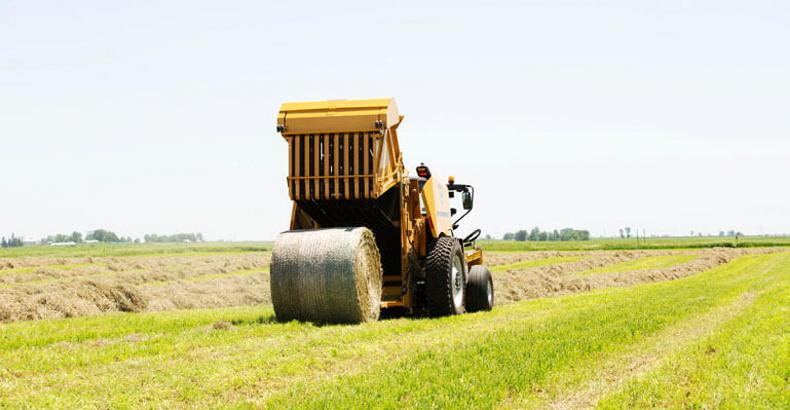
The Vermeer machine sources power from a 200hp Cummins Stage V engine, which is married up to a two-speed hydrostatic transmission.
When baling in automatic mode, the ZR5-1200 control system, paired with the hydraulic drive system, makes real-time adjustments based on field and crop conditions and opens and closes the chamber door automatically.
With the pick-up reel located under the cab, the one question I had was what was it like to bale without being able to see the pick-up.
Instead, the operator monitors grass intake through two cameras, one facing the pickup and the other showing a rear view of the machine, with both displayed on a screen in the cab. The cab is positioned over the suspension system, which Cody says leads to a very comfortable ride. It features a patented independent double A-arm suspension system.
Smart features
The machine is packed with smart features. Through the 10.4-in colour touchscreen display, the operator can monitor the bale shape sensors, real-time moisture data, the weighing scales and record the data of up to 50 fields, all as standard.
TempSense gives operators real-time insights on all major bearing temperatures through a suite of wireless sensors, to help promote preventative maintenance.
If working on undulating terrain, integrated quarter-turn technology allows the machine to place bales parallel to the swath, either to the left or to the right, automatically.
Output
Making 5ftx6ft bales, Cody said that when he pushes the machine hard, it is capable of turning out 58-59 bales an hour, when baling corn stalks.
Mainly doing their own work, the family also make bales for some neighbours on hire. They charge $12/bale (€11.30/bale), or if it needs to be raked, the charge increases to $14/bale (€13.16/bale).
Cody noted that bale weight tends to vary from 450kg up to 600kg, depending on the moisture level.
Verdict
“I rate the machine a 10 out of 10. It’s a super machine, designed to do one job and, in the right conditions, it does it to perfection.
“We got the machine in 2019, and to be honest, that year was a disaster. It was a very wet year, which saw very little crops even sowed.
The fields were wet right through the summer, and being 2WD, the machine struggled.
“One thing we quickly learned was that it’s not a machine for wet ground.
“However, since then, it has been faultless. In typical conditions, I genuinely think it will come very close to matching the output of two typical tractors and balers.
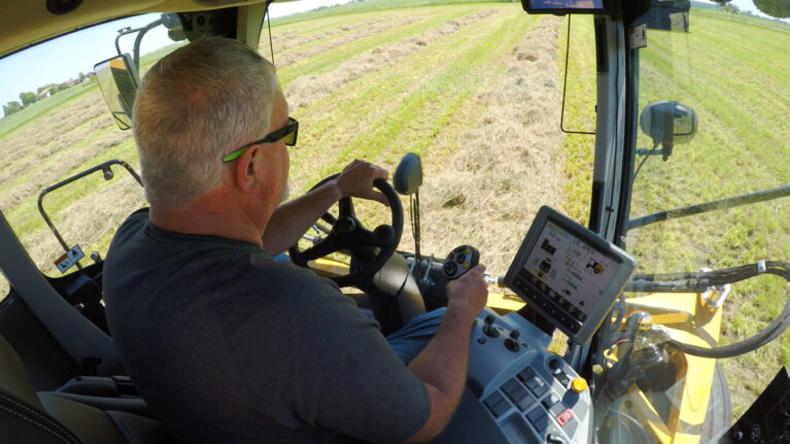
Through the 10.4-in display, the operator can monitor the bale shape sensors, real-time moisture data, the weighing scales and record the data of up to 50 fields, all as standard.
“It’s packed with smart features that make life so much easier. For example, if you get blocked, the hydraulically driven pick-up can be reversed, to help spit out the material before you start it up again, it’s a great job.
“It’s a big investment, but it’s well worth it,” concluded Cody.
Model: ZR5-1200.Engine: 200hp Cummins Stage V. Transmission: Two-speed hydrostatic. Drive: 2WD. Chamber: Variable chamber. Weight: 8,845kg.Fuel capacity: 333.1 litres. Price: $150,000 plus VAT. Likes
Huge output capacityVery comfortableLots of smart featuresDislikes
Not a machine for wet conditions
Based near the town of Corsica, in the southern part of South Dakota, the Vanden Hoek family have agriculture running through their veins. With a suckler, tillage and machinery enterprise, the business is run by Keith Vanden Hoek, and his two sons, Cody and Clayton.
The family run a herd of 210 spring calving suckler cows on 300 acres of grazing land. Weanlings are sold over three months, from December to February. Running a mix of black and red Angus cows and bulls, the herd also includes some Charolais cattle.
The family is currently calving, with all cows generally calved outdoors. Weanlings are typically sold in the local mart at a weight of 300-350kg. Last year’s crop of weanlings averaged $1,800 to $1,900/head, which is the equivalent of €1,690 to €1,780/head.
Grazing on leased ground is based on a daily rate, with the going rate for pasture grazing for a cow and calf at $2/day. Until last year, the family never made silage, all feed was dry and mostly hay. Last year, they sowed an alfalfa/oats mix, and wrapped it using an in-line tube wrapper. They were very impressed with the feed value and will continue this going forward.

This Vermeer baler features a fixed bale width of 5.1ft and a variable bale diameter of 3ft to 6ft.
The trio sow 2,100ac of crops and are aiming to grow this to over 3,000ac shortly. Last year, they sowed 1,000ac of maize corn and 900ac of soya beans, while the remainder was made up of whole crop and milo, which is a drought resilient sorghum. The rental market for tillage land in the area ranges from $175-$210/ac (€164-€197/ac). Crops are typically direct sowed, with little to no cultivation practices used on the farm. The crops are sowed using a 40ft Great Plains drill and a 16-row John Deere precision planter.
At present, the family are travelling up to 30 miles for ground, with their furthest two plots of ground 50 miles apart. South Dakota has experienced a warmer than usual winter, with weather at present dry and approximately 18-21 degrees Celsius.
Machinery dealership
The Vanden Hoeks set up Southside Farm Services over 17 years ago. The business sells new and used machinery, parts, crop seed and crop insurance.
It has the agency for Great Plains, an American cultivation and drilling equipment company, Kuhn hay and forage equipment, Vermeer and GTS specialist combine headers. The business employs two full-time staff, and the family’s mother, Val, looks after the administration work.

In 2017, Vermeer commercially launched the worlds first self-propelled round baler.
“We try to run everything on our own farm that we sell in our machinery business. That way, we have a great understanding of the machines and what our customers need.
“Our business could be described as being small to medium in size, but one that provides a very good service to a loyal customer base,” said Cody.
Self-propelled baler
Vermeer are an American company, who are a well-known and trusted brand in the United States. It has a European headquarters in the Netherlands, but by and large isn’t a recognised name in Ireland.
Vermeer has a big history with round balers, having introduced its first model in 1971. In 2017, Vermeer commercially launched the world’s first self-propelled round baler.
This wasn’t the world’s first self-propelled baler though, with several manufacturers building self-propelled square balers including Deutz-Fahr (PowerPress) and American firm Freeman.
Krone also toyed with the idea, but didn’t follow through. In saying that, the Vermeer machine is the first SP round baler on the market. 
"If you get blocked, the hydraulically driven pick-up can be reversed, to help spit out the material before you start it up again, it’s a great job".
The family has run balers on their own farm for years. Fitting with the location and the climate, the Vanden Hoek’s have always used variable chamber belt machines.
Starting off with a twine New Holland, the family moved to Vermeer when they took on the agency many years ago.
Having stuck with Vermeer since, they decided to make the move to a new self-propelled ZR5-1200 model in 2019.
“We were really impressed with the look and build quality of the ZR5-1200 and decided to make the move in 2019. The machine is built to do one job, and is a phenomenal piece of kit.
As I say to farmers, you don’t see any trailed combines anymore, and there’s less and less trailed silage harvesters, so why wouldn’t you consider a self-propelled baler?” said Cody.
The nuts and bolts
The Vermeer machine sources power from a 200hp Cummins Stage V engine, which is married up to a two-speed hydrostatic transmission. In the field, forward speed is capped at 19.3km/h (12mph), while road speed extends to 48.3km/h (30+ mph). Weighing in at 8,845kg, the machine sources its cab from Claas, and it is the same cab used in the Jaguars and Lexions.

When the bale is made, the hydraulic power to the pick-up drops, and the bale chamber runs to 300% to apply two and a half layers of net in just five to six seconds.
The Irish market is dominated by fixed chamber (4ftx4ft) balers, while the US market is the complete opposite.
This Vermeer baler features a fixed bale width of 5.1ft (154.9cm) and a variable bale diameter of 3ft (91.4cm) to 6ft (182.9 cm), designed to make a maximum bale weight of less than 1,100kg.
The drive to both the cam pick-up and the bale chamber are hydraulic and both are independent of one another.
“I would describe the machine as being just like a large zero-swing lawnmower, it performs in the same way. It’s very comfortable, and offers huge output capacity.
“The first 30 inches of the bale is formed under spring tension using forming rollers. After that, the tension moves to hydraulic density. When the bale is made, the hydraulic power to the pick-up drops, and the bale chamber runs to 300% to apply two and a half layers of net in just five to six seconds. It quickly dumps the bale, and you’re moving again. In good ground, I often bale at 12mph,” explained Cody.

The Vermeer machine sources power from a 200hp Cummins Stage V engine, which is married up to a two-speed hydrostatic transmission.
When baling in automatic mode, the ZR5-1200 control system, paired with the hydraulic drive system, makes real-time adjustments based on field and crop conditions and opens and closes the chamber door automatically.
With the pick-up reel located under the cab, the one question I had was what was it like to bale without being able to see the pick-up.
Instead, the operator monitors grass intake through two cameras, one facing the pickup and the other showing a rear view of the machine, with both displayed on a screen in the cab. The cab is positioned over the suspension system, which Cody says leads to a very comfortable ride. It features a patented independent double A-arm suspension system.
Smart features
The machine is packed with smart features. Through the 10.4-in colour touchscreen display, the operator can monitor the bale shape sensors, real-time moisture data, the weighing scales and record the data of up to 50 fields, all as standard.
TempSense gives operators real-time insights on all major bearing temperatures through a suite of wireless sensors, to help promote preventative maintenance.
If working on undulating terrain, integrated quarter-turn technology allows the machine to place bales parallel to the swath, either to the left or to the right, automatically.
Output
Making 5ftx6ft bales, Cody said that when he pushes the machine hard, it is capable of turning out 58-59 bales an hour, when baling corn stalks.
Mainly doing their own work, the family also make bales for some neighbours on hire. They charge $12/bale (€11.30/bale), or if it needs to be raked, the charge increases to $14/bale (€13.16/bale).
Cody noted that bale weight tends to vary from 450kg up to 600kg, depending on the moisture level.
Verdict
“I rate the machine a 10 out of 10. It’s a super machine, designed to do one job and, in the right conditions, it does it to perfection.
“We got the machine in 2019, and to be honest, that year was a disaster. It was a very wet year, which saw very little crops even sowed.
The fields were wet right through the summer, and being 2WD, the machine struggled.
“One thing we quickly learned was that it’s not a machine for wet ground.
“However, since then, it has been faultless. In typical conditions, I genuinely think it will come very close to matching the output of two typical tractors and balers.

Through the 10.4-in display, the operator can monitor the bale shape sensors, real-time moisture data, the weighing scales and record the data of up to 50 fields, all as standard.
“It’s packed with smart features that make life so much easier. For example, if you get blocked, the hydraulically driven pick-up can be reversed, to help spit out the material before you start it up again, it’s a great job.
“It’s a big investment, but it’s well worth it,” concluded Cody.
Model: ZR5-1200.Engine: 200hp Cummins Stage V. Transmission: Two-speed hydrostatic. Drive: 2WD. Chamber: Variable chamber. Weight: 8,845kg.Fuel capacity: 333.1 litres. Price: $150,000 plus VAT. Likes
Huge output capacityVery comfortableLots of smart featuresDislikes
Not a machine for wet conditions 











 This is a subscriber-only article
This is a subscriber-only article










SHARING OPTIONS: